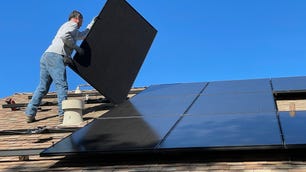
Imagine looking at a solar panel and seeing… nothing at all. That’s the goal behind a new technology Panasonic’s working on that could turn the ordinary windows of your home or walls of your office building into small solar-energy generators, without the eyesore of traditional black materials. And here’s the wild thing: these little energy farms are inkjet-printed directly onto the surface. I got a chance to learn about the concept here at CES 2024 (check out our favorite CES gadgets).
In a nutshell, perovskite (say that 10 times slow) is the name of the this type of solar technology, and it uses different materials than traditional silicon solar panels. That has a few advantages, Panasonic said. For example, the fact that the materials are printed onto walls and windows means Panasonic can manufacture components at much lower temperatures — which saves energy — and the solar cells themselves have the potential to one day capture as much energy as traditional solar panels, if not more.
That means there’s a path for technology like Panasonic’s transparent (or semi-transparent) solar “panels” to one day replace bulky rows of ink-black solar panels, and to cover vertical surfaces, not just rooftops and lawns.
Can solar panels save you money?
Interested in understanding the impact solar can have on your home? Enter some basic information below, and we’ll instantly provide a free estimate of your energy savings.
Because the application Panasonic is pursuing is transparent or semi-transparent (and doesn’t soak in solar energy the same way as opaque panels), not every cell will hit the maximum efficiency. Panasonic can vary the transparency of the cells, making darker windows that capture more energy or lighter windows that are easier to see through but that are less efficient.
The design of these solar cells can change, depending on what they’re for. For example, a single commercial building might have darker windows at the top and lighter ones at the bottom, using a variety of efficiencies in one application. The inkjet printing process also lets manufacturers to customize products and designs for different needs, Panasonic’s Yukihiro Kaneko told me.
Panasonic is still in the research and development phase and doesn’t expect to be able to deploy this tech for a few years, but the company said it’s testing equipment at efficiency levels up to 18.1% (meaning it captures that much of the available energy). That efficiency level is just a little lower or on par with residential solar panels.
AI Is Everywhere at CES 2024. Here’s the Coolest Tech We’ve Seen So Far
Perovskite solar tech: See-through power potential
To recap, perovskite solar cells are made from a different material than your typical silicon solar panels. Perovskite halides, to be exact, which refers to a wide range of inorganic or organic compounds that can be manufactured fairly easily.
On a chemical level, one advantage perovskite cells have over silicon panels is that the manufacturing process is less energy intensive. It largely involves the mixing of organic and inorganic compounds, and all of it is done at temperatures below 200 degrees Celisus, Kaneko said. The production of silicon cells involves higher temperatures. “We don’t use any high-temperature treatments in the process,” he said.
As with your own home, the higher your energy needs, the higher the cost. It may be that lower-temperature treatments could be cheaper to produce and therefore easier to scale and eventually sell to corporations and consumers.
Although the (semi-)transparent solar cells using perovskite may be less energy-efficient in this research and development phase, in research testing by the Department of Energy’s Solar Energy Technologies Office, the cells have shown to be capable of even higher efficiency than the usual silicon variety. Solar cells that use both silicon and perovskite have demonstrated efficiencies of nearly 30% in lab conditions, combined to around 26% for silicon cells.
The DOE said the main difficulty with producing perovskite cells has been the life cycle of the compounds — they don’t last as long as their silicon counterparts.
While the concept of an ombre skyscraper that generates its own energy is appealing and fits right into a growing trend of transparent and semi-transparent solar cells, including the energy-generating stained glass I also saw here at CES. Other companies are also working to roll out solar windows.
Stick with CNET for the wackiest tech at CES 2024 and our cutting-edge favorites.

